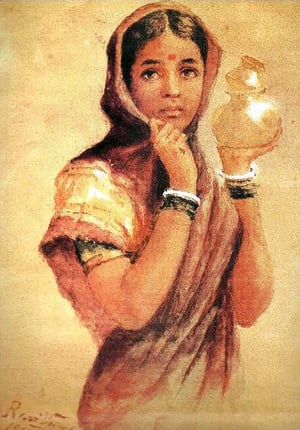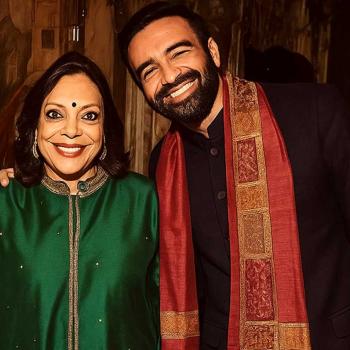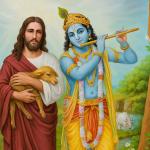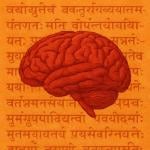When the sex scandal of Swami Nithyananda suddenly erupted on March 2, 2010, I was already in Delhi as part of a group to go toKumbh Mela. I was also finalizing my new book which deals specifically with Tamil Nadu religious politics, and in particular with the role of various nexuses based overseas. So I decided to jump into the eye of the storm of this scandal in order to investigate whether similar nexuses were at work in this case. Naturally, at one level I have seen this scandal through the framework of a civilization encounter in which Vedic culture is pitted against the Dravidian divisiveness that is beingbacked by Christian evangelism. At another level, I found that the sensationalized media reports were too one-sided, and none of them had a single statement to report from the swami himself. Furthermore, there was chaos and mismanagement of the crisis from Swami Nithyananda’s inner circle.
In hindsight, things might have turned out differently had they managed more sensibly and faster which I will elaborate later in this article. Given this, another interest of mine has been to extrapolate important lessons from this episode for other Hindu organizations, which I predict will face similar scandals as and when their weaknesses become understood by those opposed to them. This article highlights my findings at these multiple levels and issues.
During this 2-week investigative period, I have been loyal to my pledge to give Swami Nithyananda’s organization the benefit of doubt and to report their side of the story. Besides wanting to balance out the one-sided media depictions, I wanted access to the ashrams core group for my own research on the broader subject of civilization encounters. I respect the sensitivities of that organization consisting of many decent and dedicated devotees who have sacrificed a great deal and stand to lose a lot.
But I have concluded that the situation is now beyond repair for Swami Nithyananda and that his continued involvement can only damage the broader interests of dharma as well as jeopardize the ashramites. Along withtwo other sympathizers who are not ashramites, I have personally recommended to Swami Nithyananda that the best course at this stage would be for him to resign completely from his organization.
He should turn it over to a small team of senior Hindu mahatmas, so that the assets can be used in the best interests of dharma. Further, under the guidance of these mahatmas he must live a quiet life as a sadhu devoid of any institutional responsibilities. Because the head of any organization must accept responsibility that the buck stops here,only such a move can salvage the organization and the reputation of dharma at large. Over several years, this resignation would hopefully reduce the massive pressure that has built up against him personally, and enable him to live peacefully as a sadhu. It is up to him to accept or reject this advice. The basis for this conclusion becomes clearer once the reader has gone through the rest of this article.
I want to begin by examining some principles about the relationships between siddhis (extraordinary yogic powers), morality, Tantra and sex. This will provide the framework in which to interpret what has happened. Then I will turn to my initial interest in pursuing the challenges facing Hinduism in south India from a variety of forces.
Siddhis (Extraordinary Yogic Powers)and Morality
A few days ago, I had the honor of having a two-hour private conversation with Sri Sri Ravi Shankar at his ashram in Rishikesh. I introduced myself as an independent researcher who is writing a series of books on Indian civilization in the context of the global challenges and opportunities. One of my volumes will be specifically on the major global gurus since the 1960s including Krishnamurti, Swami Muktananda, Maharishi Mahesh Yogi, Pabhupada, among others – as well as living global gurus such as Sri Sri himself. I have been investigating what happened to such gurus, in terms of the shifts in their Western followers over time, their scandals, their Indian followers and critics, and also how each guru negotiated his/her position sandwiched between Indian orthodoxy on one side and Western modernity on the other. The relevance of this in the context of Swami Nithyananda will become clear very soon.
The first provocative question I asked Sri Sri concerned the nature of yogic powers: What is the relationship between siddhis and morality? If siddhis are a scientific phenomena dealing with powers that can be harnessed by all humans then one must bear in mind that science deals with truths that are morally neutral. If Einstein was declared to have lived an immoral life it would not invalidate his scientific theories. A person who designs aircrafts or any other complex technological systems may or may not be moral in order to be effective in his technical work. In other words, rtam (the patterns of the cosmos) which we discover and call science, functions independently of human morality. This is why a scientific principle can be used either morally or immorally, because it is independent of morality. There are moral persons who lack any siddhis or even ordinary scientific competence. Conversely, there are great siddhas (like Ravana) who lack morality. Sri Sri’s Pranayama techniques would also produce results for an immoral person.
Sri Sri seemed impressed by this question, and agreed with my overall position on the independence between siddhis and morality. But he pointed out that the moral dimension, while not determining the siddhis, was also important because it led to receiving the grace of the divine. I agree with him.
So there are two separate phenomena involved:
(i) spiritual technologies that are objective and that allow anyone to harness spiritual energies, and
(ii) morality which is important in itself, not for attaining siddhis, but in order to have a positive relationship with the divine.
Either one can be developed without the other; however, the dharma tradition encourages us to cultivate both.
The reason that meditation systems prescribe things likevegetarian diet, ahimsa, etc. is because an inappropriate lifestyle interferes with the mental tranquility required to advance. This lifestyle change can be appreciated regardless of whether one believes in a personal God. This absence of a personal God is clear in Buddhist meditation. Different Hindu systems place different levels of emphasis upon a personal God for the yoga to function. This is why many secular and scientifically minded persons are also drawn towards meditation techniques. In other words, something cannot be a science if it depends upon morality, because science is objective and stands independent of morality.
The relevance of this question is as follows: Many persons who have learned advanced meditation from Swami Nithyananda want to know if any moral breaches by him would invalidate the whole Hindu claim of achieving higher states of consciousness. When a far worse sex scandal against the legendry Swami Muktananda emerged in the 1990s, involving charges by a large number of his Western female disciples, the Western academy rashly condemned not only one mans morality, but the whole legitimacy of the Indian tradition itself. In that series of debates (with Risa scholars like Sarah Caldwell, etc.), I took the same position then as I am taking now: that Muktananda’s capabilities in harnessing spiritual energies are separate and independent from whether or not he violated any code of morality.
Patanjali warns against getting lured by siddhis which appear along the way when one practices advanced meditation persistently. One is not supposed to indulge in them. This warning is found in various Hindu systems that deal with the body as a vehicle for spiritual evolution, because these energies are very powerful and can get out of control. Another point that is worth noting is that the techniques taught by Swami Nithyananda are not his original ones; he has made it clear repeatedly that they are from the Shiva Sutras which have a long history in our civilization. I feel that he does have the siddhi of being able to transmit these techniques very effectively to others. For instance, I have never before in my life been able to sit still and alert in meditation for the whole night, but he had a few hundred persons in a large hall achieving this. The point here is similar to saying that the mathematics and golf I have learned from someone is not invalidated when the teacher is found to be immoral.
Hence, the issue of his morality must be pursued separately and independently from whether his siddhis are genuine.
Is Tantra a Part of Hinduism?
The second question that I asked Sri Sri could not be completely dealt with in the time available for our meeting. I hope to pursue this some day with him and with various other acharyas for my own benefit. Its significance in the present scandal becomes clear soon. I asked whether the Shiva Sutras are valid, pointing out that among the 112 spiritual enlightenment techniques taught in them, about 6deal with sexual contact between a male yogi and a female yogini. Kashmir Shaivism as well as the Tantra traditions have included exemplars that practiced these techniques. Recently, Osho tried to revive them and nowadays Deepak Chopra has brought some elements of these into his repertoire. Sunthar Vishvalingam, a US based scholar of Tantra and Kashmir Shaivism, is one of the voices who brings out the authenticity of these approaches in the tradition, despite the common rejections by society at large. The tradition considers itself not suitable for mainstream society and is meant only for a small subset of people.
Many popular Hindu rituals and symbols have emerged out of the Tantra traditions such as Shiva lingam, etc. The Tantra and Vedic traditions were not separate until recent times. The Vedic-Tantric integration is found in Adi Shankara all the way to Jiva Goswami (the great integrator of Vaishnavism who took Ramanujas ideas further), and even more recently in the life of Sri Ramakrishna.The Bihar School of Yoga has Tantra practitioners, but they do it privately and not publicly.
I have an unpublished monograph that shows the history of this shift in Indian consciousness concerning Tantra. It was under British rule that certain Indian leaders (such as Ram Mohan Roy) started to condemn (as part of their reform of Hinduism) those aspects of Hinduism that bothered puritan Christian values. It must be noted that Christianity has had a very negative posture towards the human body starting with the Biblical episode of Origin Sin. This is why female priests (called witches) got demonized by the Church in its very official genocide of several million practitioners across Europe. This Church prosecution was called the Inquisition and was widespread for a few centuries. The use of shakti and anything concerning the body as a spiritual resource was considered not only immoral but also demonic, and was outlawed with draconian enforcement. The term occult was used to refer to a vast assortment of such practices and was heavily condemned by the Church as the work of the Devil.
This mentality entered India under the British. The Criminal Tribes Act of India was passed by the British in the late 1800s. It listed several dozen tribes that practiced such evil techniques, and they were officially persecuted into extinction. A middle-class whitened Hinduism evolved as the mark of being civilized on British terms. We could be proud of our identity, now that it was cleansed of primitive practices of our ancestors.
In this history of removing Tantra out of Hinduism, some people include Swami Vivekananda among those who undermined Tantra. I disagree with this charge. He was saying a separate set of things to his Western audiences than to Indians. In his Western lecture tours, he presented a Hinduism that Westerners could relate to and appreciate, but he did not ask Indians to shift their practice. It is unfortunate that after his death,the Ramakrishna Mission he started has diluted itself into a sort of pseudo-Christianity. Kali and other related Tantra deities, symbols and rituals that were dear to Ramakrishna himself, have become hidden for the private use by the monks, but are marginalized publicly and considered as an embarrassment. Their lead in this direction has spread across modern Hinduism to such an extent that Vedic Hinduism has become separated from Tantra, and Tantra is now widely condemned by many Hindu gurus. This is also a factor that worked against Swami Nithyananda’s reputation among orthodox Hindu leaders, for he uses Tantric techniques that arouse body energies, such as kundalini.
My own feeling is that Tantra is making a big comeback. First there was Western popularity of distorted versions of Tantra; but this is now being followed by more clinical experimentation by psychologists and others. The whole issue of latent human energies and potentials (both positive and dangerous) is a hot topic of serious scientific investigation. Hindus should reclaim this aspect of their own tradition rather than waiting for U-Turned (appropriated) versions to get re-exported back to India, packaged as Made in USA spiritual science. This requires an attitude of experimentation under the appropriate controls to prevent abuses and quackery.
I just returned from Kumbh Mela where I walked amidst several tens of thousands of naga sadhus who were completelynaked. I did not consider them as either vulgar or primitive. The old guard of Hindu orthodoxy rejects Tantra at least in public, and yet lives in contradictions because they do respect the naga sadhus and also the various symbols and rituals that have their foundations in Tantra. The vacuum left by avoiding the subject of Tantra has created opportunities for the likes of Wendy Doniger to formulate distorted interpretations. I feel thatHindu spiritual practitioners as well as intellectuals must take control over Tantra as an intrinsic part of our tradition.
Sex and Morality
Against this backdrop, I will address the issue of Swami Nithyanandas morality.
Just to recap:
My first point above has been that the morality issue about Swami Nithyananda does not impact the effectiveness of the meditation techniques he has taught very successfully. Their efficacy is best evaluated by the tens of thousands of practitioners for themselves.
My second point was that there is nothing inherent about sex that is rejected by Hinduism across the board, althoughcertain strains of Hinduism do reject sex seeing it as harmful to spirituality.
Here it must be noted that brahmacharya (involving sexual abstinence)is just one of the spiritual paths of Hinduism. The first half of my recent stay in Haridwar was as a guest of the Gayatri Pariwar, one of the greatest and largest Hindu movements, that does not advocate being brahmacharya. Its founder, its present head and its members at large, are householders and not brahmacharyas. But for Swami Nithyananda to claim moral authenticity under this system, he would have to pronounce himself as a householder and not a sannyasin. He has never done that, so we must examine his morality by some other criteria.
Another approach for him could have been to announce himself as an experimenter of Tantra for modern times, thereby making himself transparent of any such charges. This would place him in the same category as Osho. Many times in his public discourses and teachings, he has praised Osho as his greatest teacher and enlightened exemplar. He even said that many of his own teachings were derived from Osho. But he failed to publicly clarify whether he was practicing those techniques that involve sex. Privately, he explained to me in recent days that Shiva Sutras have two categories of techniques.
Most of the sutras donot involve physical contact with another person and only use the four senses of sight, sound, taste and smell as pathways to spiritual experiences. Hence an individual practices these techniques entirely on his/her own. This path is what he has taught thus far to the public. The best pursuit of this path is as a brahamacharya according to him, and he has initiated many followers into it. But for a small number of persons, he feels that the 6 sutras involving sexual Tantra need to be tested and perfected for modern times, before they can be safely taught more widely. This he considers like any R & D done in a lab for developing a product.
My sense is that he did practice Tantra with a very small number of persons, and I believe that he even entered into written legal contracts with them to make sure that both parties were clear about the arrangement. The reason for this Non-Disclosure Agreement wasto make sure that someone who willingly approaches him for Tantra does not later accuse him of physical contact. On March 9 (about a week ago), I did a specific video interview with him dealing with this issue very specifically. But this video was blocked by his ashram leaders even though he personally felt that it was a good idea to show it. I gave up arguing in favor of showing it, because his ashram management took a firm stand against it. I still feel that this was a blunder they made. Swami Nithyananda is very forthright and clear in that interview I felt that it was the best interview of all the ones I did with him, but it was never made public.
I surmise that Rancitha, the Tamil actress in the scandalous videotape, was practicing Tantra with him. He taught her the self-control she had to achieve before any intimacy. I have tried to interview her in order to get her side of the story, but so far I have not succeeded in getting through to her. Based on third party reports from some persons who are in touch with her, and the media reports of her statements, her stance seems to be along the following lines: She took the sexual initiative with him on the occasion shown in the videotape, at a time when he was not fully alert. But this activity did not proceed to intercourse. It was terminated. She has also said that the videos being shown on TV are manipulated versions of what actually happened, because they exaggerate the situation. They do not show portions where he asked her to stop. Different clips from various videos seem to have been turned into a single video by editing. She has not filed any complaint against him. So in the worst case, this was consensual sex between adults, and that too backed by a formal written contract between the parties. Because she has refused to give any statement against Swami Nithyananda, she feels threatened by those who set her up and who did this sting. I hear that she has gone overseas to protect her safety from this mafia-like conspiracy. I have not been able to corroborate this thesis directly from her.
My concern about his morality is, therefore, not based on sex between consenting adults. Rather, my moral issue is about the lack of transparency before the public. He could have openly said that he wants to select a few yoginisto experiment Tantra under mutual consent. At worst this would have upset many followers and pushed them away. In response to my concern over his lack of transparency, he could offer the argument that this was a private activity between adults who areunder no obligation to disclose it to the public. After all, people do not go about broadcasting their sexual lives. So long as this was under mutual consent, he might say, it cannot be an offense. And if it was done under the Tantra portions of the Shiva Sutra, it was also an act within the Hindu tradition despite the controversy surrounding Tantra today.
Having given this best case argument on his behalf, I must say that there could also be the alternative scenario, namely, that this was mere lust packaged as Tantric spirituality. David White, one of Wendy’s Children, has written extensively making the claim that all Tantra is hard core porn that gets wrapped up before the public in metaphysical mumbo-jumbo to appear to be legitimate spirituality, which he calls soft porn coating. Whites latest book takes this allegation to the extreme, and states that all major yogic exemplars in Indian history were basically not engaged in any kind of spirituality at all. Instead, he claims, they were developing personal power for the purpose of exploiting others. I am unqualified to comment on whether Swami Nithyananda’s case fits this notion of soft porn, or whether it was legitimate Tantra. Nor do I have adequate factual data of what happened to pass judgment either way.
This concludes what I have to say about his morality issue as shown in the sex tapes.
My Impressions of Swami Nithyananda Prior to this Scandal
I was introduced to Swami Nithyananda a couple of years ago, by a prominent Hindu leader based in California. This man was so impressed by the young swami that he frequently called me to speak about him in glowing terms. I told him that I had a guru already, and that my present interest in interacting with gurus was mainly as a part of my research for my book on global gurus. He arranged a private meeting for me with Swami Nithyananda which I used mostly to explain the civilization threats facing Hinduism, citing numerous examples, and questioned him on his position in this regard. I found him to be very sharp, a great listener, and in agreement that we must engage social issues rather than pursuing the world negating or escapist paths that are typical of many gurus today.
Later on, I attended a weekend course in USA, where he taught the Patanjali Yoga Sutras. I have read several translations of this great classical work, but I had never before seen it taught experientially. Swami Nithyananda gave the attendees their own personal inner experience of every one of the eight limbs of Patanjalis system, right up to and including samadhi. This was quite an achievement in two days.
Overall, my interactions with him remained centered largely on the geopolitics of religions. I saw him as a prominent swami who was not running away from troubling issues, such as Christian conversions and the Dravidianization of Tamil identity. Given that I have been writing a book on this very issue in Tamil Nadu for three years (now in the editing stage), I was especially impressed by his experimental program of a Hindu temple on wheels traveling from village to village. In each village this mobile temple stops and offers chanting, a talk by one of the leaders, food, medicines, etc.
So it combines religion with social service and thus competes directly against Christian evangelism. Rather than building a temple in every village and needing a purohit in each of the thousands of villages across Tamil Nadu, the strategy was to bring to each village this temple on wheels.What I discovered by my own independent fact finding was that wherever this temple on wheels went, the missionaries were upset because it blunted their conversion efforts.
I attended his 21-day meditation program in December 2009. The various techniques in it are very deep and transformative. The best evaluation of this can be doneby the hundreds of attendees, who were divided roughly equally between Indians and whites from North America.
In several side conversations with him as well in the public forum, I pursued the point that I already have a guru since 1994, so I was not looking for a new guru. Since my guru had left the body a few years ago, I wanted to continue learning new techniques for my practice. I explained to him that I had previously learned and practiced meditation techniques from multiple sources for over 30 years, including: Maharishi Mahesh Yogi, Sri Sri Ravi Shankar, Yogi Amrit Desai (who certified me as a teacher), Deepak Chopra, Vipasana, and more. Additionally, I had practiced numerous bhakti traditions, as well as formal Vedanta education from Swami Chinmayananda and Ramakrishna Mission. I went through a serious study of the writings by Sri Aurobindo, various Madhyamika Buddhist systems, Kashmir Shaivism, Ramana Maharshi, etc. So I was not seeking a new guru like most others who took his courses.
I have to say that he never pressured me to adopt him as my new guru, and even said that one must remain loyal to ones guru. To be classified as a devotee/disciple of his, there are two criteria, neither of which applies to me. First,there is an optional program one can sign up for, to do paada puja at the gurus feet, in order to develop a special link with him. The second is that one can ask to be given an initiation with a new name, in which case his policy is that the person must legally change his/her name, and use this new name publicly. I did not do either of these steps. So my relationship is not as a devotee or disciple, but more arms-length.
It was a two-way street. While he taught me meditation, I brought to him my scholarship on the geopolitical positioning of Hinduism which I feel the gurus know only superficially. They do not adequately know things like: Western philosophy, neither religious nor secular; or Western history; or Western institutions that have been set up explicitly to spread its civilization; or various global campaigns under way to invade Indian civilization through conversions, education, media, political policy making and more.
He requested that I should present him my findings on such matters so that he and his senior acharyas could learn. I told him that most gurus have little time to listen attentively to a layperson like me, because the gurus like to do all the talking. He replied that he would sit and listen to me seriously. I made it clear that I was disinterested in giving a short talk of a few minutes, because my findings required considerable time to be examined seriously. I told him that I would need two full days of undivided attention, so that I could present 300 Powerpoint slides.
Swami Nithyananda sent me an invitation when I was in Delhi to visit his ashram and present my research. I was delighted to have such an important audience. I was very impressed by the fact that he sat through two long days of my talks, about 12 hours per day. He asked his 40 top acharyas and various thought leaders in his ashram to sit and listen to me for both the days. The interactions were intense, and I explained many points from my forthcoming books. I felt that he and I had a peer relationship, each side being an expert in his domain to teach the other. After my two days of talks were over, he asked me to help him incorporate my core ideas into his curriculum, so as to make sure that his teachings helped position the Vedic civilization properly.
No other guru in the world has invested so much time with me to try and learn these global issues so deeply. (The only other prominent guru I know personally who understands these issues about the external challenges is Swami Dayananda Saraswati.) Most gurus tend to either be dismissive by resorting to spiritual loftiness, or imagine that they already know whatever there is worth knowing. Thus, my primary interest in Swami Nithyananda was as a vehicle to spread greater awareness of the kinds of issues that I was researching. (For instance, he bought a couple of hundred copies of the book, Invading the Sacred at the full price, and made it required reading for all his ashram residents.)
I must balance this praise with criticism. In my 2-day talks, I had explicitly discussed that many gurus were falling prey to sex scandals, often with women planted as part of sting operations, or women in the inner circle who got too close and let things get out of control. Despite these warnings, it seems that nothing concrete was done to prevent or at least anticipate the crisis that was to follow.
My Approach to this Investigation
When the scandal broke out I was in Delhi. I called the Bangalore ashram management and found them confident but confused. Probably they felt that the matter would soon get forgotten if left alone. But exactly the opposite happened,as each day brought fresh allegations and sensational media coverage. After several days had passed I was invited to go to Bangalore tostudy the situation for myself. At that time I had no clue about his Tantra practice with any women. Whatever I knew was based on what his followers told me, because he was personally inaccessible for several days even after I reached Bangalore. I spent many hours daily with some of his ashrams top team.
What I wrote earlier in this article actually comes later in the chronology of my investigation. But I presented it up front because most readers are obsessed with getting my answer to only one single question: did he or did he not have sex? Nothing else seems to matter to them, whereas my investigations emphasis has been about issues broader and more consequential than any one mans morality.
Until I concluded my fact-finding 2-week period recently, I was unable to discuss the sexual acts shown in the videotapes. I had to respect the policies of his people as part of the trust being placed in me to gain access. They also needed legal clearance on what can and cannot be said by them. Their policy on the sex tapes was that Swami Nithyananda would directly explain his acts. The Tamil actress lawyer was also in contact with them and her sensitivities had to be respected. The sensitivities of the 140-strong ashramites had to be protected also. Given this set of circumstances facing me, I feel that it was unfair to demand that I should hound him with the one critical question. People have assumed that it was up to me to decide what would be within the scope of each interview. As I have mentioned earlier, even after certain interviews were recorded by me, the ashram leadership used its discretion not to air them.
In response to my critics on how I conducted my interviews, I would also like to explain why I chose to focus on the criminal charges being made against Swami Nithyananda. Besides the sex-tape being off limits as mentioned in the foregoing paragraph, the criminal charges became my focus for two reasons. These charges could be ascertained with objectivity such as asking for documents on the land ownership, the medical reports on the death of one meditation participant 2 years ago, and so forth.
The evidence was more clear-cut than the evidence on what exactly happened in the videotapes between two persons none of whom were willing to talk with me about it. Secondly, the consequences of criminality would be far more severe than mere moral fallibility. While immoral conduct is a big concern for the devotees, it is not enough grounds by itself for the state to confiscate the entire property that runs into very large sums of money. Also, as a matter of principle, regardless of whether or not he is guilty of the morality charge, I felt opposed to spurious criminal charges being piled up by the irresponsible media just to create sensationalism.
The Conspiracy against Swami Nithyananda
Since I had arrived at the scene while writing my book on the conspiracy in Tamil Nadu religious politics, it was natural to start with that as my emphasis for the investigation. But in this short article I have decided to focus on the matters surrounding his conduct and his organizations conduct, because these have assumed a more urgent nature. The details of the conspiracy belong in my book as corroborating evidence for my thesis there. The types of parties reported to be behind the conspiracy, both foreign and India based, were remarkably similar to the ones I have written about in the book. So for now I shall merely summarize some of the main points concerning this conspiracy.
First one must understand why Swami Nithyananda became such a target. He was virtually unknown 7 years ago, but once he appeared in public his popularity catapulted at a dramatic rate. For example, last year, YouTube wrote to him that he was the most watched of all Indian spiritual leaders on the Internet and proposed a closer collaboration for their viewers. This letter also stated that among all spiritual leaders worldwide (not just Indian) he was the second most popular one, the Vatican being first. His meditation programs have become very popular in USA and in certain Indian states. The main factors are that participants almost invariably report experiencing higher states of consciousness, and he has healed a large number of persons of a variety of diseases. His healing powers are what brought together his core inner group of devotees from around the world doctors, businessmen, IT professionals, corporate executives. Many of them have explained their personal healings from terminal illnesses as the turning point in their lives. His meditation programs sometimes bring up to a few thousand attendees for periods ranging from a few days to several weeks.
While the funds come mostly from upper strata participants in India and USA, a large portion of the expenses have been allocated to develop grass-roots social and spiritual programs focusing primarily in Tamil Nadu, his native state. This is where he is seen as a threat by Dravidian as well as Christian forces. For instance, in December 2009, about 600 villages across Tamil Nadu sent their local Nithyananda leaders for a celebration and planning session in his main ashram near Bangalore. I happened to be present for the event. These common folks, mostly from the lower strata of Tamil society, had walked 300 kilometers for this journey which they saw as a spiritual pilgrimage. The reason for the anger of Christian and Dravidian forces is that his activities have put a dampener to conversions in many districts, and several Christians have return to Hinduism by getting initiated formally into his organization. The swami himself has spoken against conversions, and has also stated that the Dravidian movement had made Tamil people unspiritual in their lives, and that this had caused social decay. His Tamil language publications and courses have become his most popular ones, far exceeding the numbers in English. Also he is a very big threat because he is not a Brahmin. Because he cannot be targeted using the classical attack on Brahmins, and because the masses in Tamil Nadu were rising to swell his ranks, the threat he posed to the existing political power structure had to be stopped one way or another.
The attack against Swami Nithyananda has consisted of two prongs, image and legal. At first a highly sensational sexual charge was broadcast in order to devastate his credibility and create an atmosphere in which any and all kinds of outlandish allegations would be taken at face value. Once the media and popular sentiments had been turned against him, there was one amazing allegation after another in rapid sequence. It was clear that none of this was spontaneous but was being centrally orchestrated under a systematic plan.
What became evident to me was that there was cooperation in informal and unofficial ways among the media, police and lower level judiciary. In fact, many third parties were aware of the attack in advance and had warned his people before it happened with specific details of the plan. For instance, one of his top devotees got a phone call from someone based in New York describing the media and police attack that was to come. His predictions turned out to be accurate but at that time the ashramites did not take the threat literally. He said that for the right sum of money he could be helpful in preventing such an attack. He claimed that the planning for this attack had started a year ago. He mentioned that a budget of Rs 200 crores was allocated by some overseas groups to demolish Hindu gurus especially in south India, and named two south Indian churches as the nodal agencies to coordinate this strategic plan. (I am presently pursuing these leads as part of my book investigation.)
There was another concrete extortion effort about eleven or twelve days prior to the scandal breaking out. A lawyer contacted them and claimed that his client had compromising videos, and that the client was seeking money or else they would get released. The same intermediary later sent a letter containing a variety of unsubstantiated criminal allegations against Swami Nithyananda, and this letters distribution list included India’s Prime Minister, President, Sonya Gandhi and Rahul Gandhi, various Chief Ministers and police heads, various national criminal investigation and security organizations. I have a copy of this letter, and it makes the Nithyananda organization seem like a terrorist outfit that needs to be attacked for the sake of public safety. This letter along with a DVD of the sex video was delivered to the Chief Minister of Karnataka state two hours before the videotape was first aired. Clearly, the attack was well planned and executed across many locations, and was persistently carried out over several days. This is not the work of some isolated individuals.
There were warnings given to individuals in the ashram that their phones were being tapped and that they better leave to save their own lives, because something horrible was about to happen. One friendly man based in Pune who runs a magazine and is a devotee of Swami Nithyananda, told the ashram a week in advance of the attack that some such catastrophe would happen. He named his source as a man in Bangalore press club. Another publisher in Hyderabad who distributes Swami Nithyanandas books in Telugu, called three times to warn that a graphic video would be released and gave a precise time for this to happen. It was also reported that an American devotee who had fallen out of the ashram was working in association with Jody Razdik who specializes in guru bashing at a prominent web site. He was being helped by an Indian based in San Diego, who was once very deeply involved inside the Nithyananda organization but had turned malicious. The only man who has openly come out as the main accuser was an ashramite who had a falling out when he got demoted due to his conduct. It was recently reported that he had a prior criminal record against him but nobody in the ashram had checked out his background before admitting him.
There were constant threats received to harass the ashramites and scare them away, with claims that narcotics will be planted to cause arrest warrants. The actions by the police were being leaked to the media ahead of time and even to the opposing side, leading to numerous tips received by friendsasking the ashram dwellers to run away before the attack comes.
But even after a couple of weeks since the scandal has erupted, the lawyers for Swami Nithyanandas ashram have failed to get copies of any concrete charges filed with the police, except a few trivial ones. Each time they approach for specific details they are told that there is no formal charge, except relatively minor ones. So the intimidation has been carried out mainly through media reports, without any legal due process starting where facts and arguments could get cross-examined. This lack of formal charges has enabled an atmosphere of intimidation using rumors and threats that cannot be pinned down officially.
It is important to contrast this with the manner in which Indian media treats scandals facing Islamic or Christian groups. The numerous scandals occurring overseas often get blocked by Indian media entirely,or are given mild treatment with tremendous sensitivity, in order to be seen as secular and not communal. By contrast every kind of allegation against any Hindu group gets clubbed in one homogeneous category and treated as a social scourge equivalent to terror groups.
The medias hounding mentality and mafia tactics deserve to be condemned. In the Swami Nithyananda case, they have used carrots and sticks to lure and threaten, using whatever would get them more sensational footage. Several TV stations and journalists camped out in Haridwar and sent me emails requesting my help in arranging an interview. When I failed to deliver (because it was not up to me to deliver any such thing), some of them turned nasty against me. One TV woman promised the swamis people positive coverage if she got an exclusive. But after the interview, she betrayed and turned it into more distortion and smut. This led Swami Nithyanandas handlers to give interviews to more stations in orderto counteract this distortion. But the more they said before TV cameras, the worse the scandal became. One station was blatant in its threat to the swamis assistant: If you dont give us an interview right away, we will show you the power of the media to destroy you. At one point a major TV station also wanted to drag in Ramakrishna Mission with similar allegations, but someone was able to stop that.
Failures of Swami Nithyanandas Organization
Hindu tradition separates three kinds of varna (skills), each representing a form of social capital,and these three were never supposed to be concentrated in a single person, thereby preventing too much concentration of power. I use the terms Brahmin, Kshatriya and Vaishya not as birth based caste, but as merit based social capital and areas of competence. The Brahmin job description focuses on spirituality and research; Kshatriya ongovernance, politics and leadership; and Vaishyas on commerce and financial capital. Swami Nithyananda had persons with Brahmin qualities performing duties that demand Kshatriya and Vaishnav skills. This was counterproductive. The ashram leaders were selected and trained for skills and roles that are very different than this situation demands. Too often their bhakti and spiritual practice substituted for professional competence in managing a rapidly growing global enterprise. The sole emphasis was placed on traditional Brahmin qualities, and none on what would be considered Kshatriya qualities.
For example, there are a large number of white devotees who do have Kshatriyata – leadership expertise, courage and commitment. But even after this attack the ashram organization has blundered in its failure to leverage and deploy them.I met some of these Westerners at the Kumbh and found them remarkably willing to stand up for their guru, but nobody had bothered to organize them and take advantage of the fact that Swami Nithyananda has a global following. Instead of such initiatives to deal with the crisis, his organization was in utter chaos, reacting to each hit by the other side. Its leaders were running scared, driven by one rumor after another. Decisions were being made in desperation and panic. The group was cognitively disoriented and many of its members were psychologically breaking down.
The organization was too much of a one-man show with the leaders operating like children dependent on the swami for every decision. The swami had become the iconic object of the ashrams inner circle. Their proximity to him became their measure of personal power and identity. This is classical cult-like behavior that cannot survive the onslaughts that are inevitable nowadays. Such a concentration of varnas into one man not only makes an enterprise incompetent, but it also can also get into the leaders head and make him power hungry. Especially when the guru has siddhis, this power can easily become co-opted by his ego into a dangerous mixture. The result is that he surrounds himself with psychopaths who tell him what he wants to hear, and this feedback loop of self glorification turns into group delusion.
I noticed this in the form of the inner circles inability to make common sense judgments, and their misrepresenting the facts to their leader by giving him too much good news. The result was that the honest truth did not come out fast enough to allow pragmatic and realistic planning. I had a difficult time to get dependable information, and the stories kept changing not only over time but also between one person and another within the group. I could not tell if there was a cover up and if new lies were fabricated to cover prior lies. In such an atmosphere one cannot tell which individuals might have a separate stake and vested interest from the group. Lacking competent Kshatriyas, the swami had not anticipated that such a crisis was ever possible, despite the fact that outsiders (including myself in my 2-day talks at his ashram) had explained to them the threats facing every prominent Hindu mahatma today.
While on the one hand I blame those in positions of responsibility at the ashram, ultimately Swami Nithyananda bears the responsibility as he selected them, defined their roles, evaluated their performance, motivated and supervised them very closely. In this regard, his spiritual capabilities hadfailed to evaluate those very close to him as well as the external reality. An enlightened master must do better than this, or else he must not try to control everything so personally.
I acknowledge that being a global guru is very demanding today, given that one has to represent a very old tradition authentically and yet in a manner that appeals to modern people. This is why Hindu leaders need a crash course on matters that are well beyond the traditional education in their own sampradayas (lineages).
Hindu Chaos
Swami Nithyanandas own support base in India has started to distance itself out of self preservation amidst all the rumors and slander. His closest supporters were not approached soon enough with his side of the story, and by the time they were approached the damage to his credibility was already irreversible. They did not want to risk being associated with a fallen guru. Many Hindu gurus have started to publicly lash out against the fallen godman;others became silent or neutral publicly, while offering private sympathy but refusing to stick their necks out.
One factor is that the swamis approach was too conservative for some and too liberal for others. It is too filled with deities, symbols and rituals of a very orthodox kind for the aesthetic taste of modern global gurus who propagate a whitened, Westernized clean Hinduism that is abstract and metaphysical but devoid of imagery associated with primitive paganism. At the other end of the spectrum are orthodox Hindu leaders who find his idea of youthful dancing, celebration, and liberal atmosphere to be not real Hinduism. A couple of shankaracharyas interviewed on NDTV lashed out against falsegurus and claimed that only the shankaracharyas had the authority to certify who was qualified to be a guru. So Swami Nithyananda fits neither end of this spectrum.
Many of the gurus I met have told me in confidence that they fear that similar attacks are coming to more Hindu gurus, but that there is no central Hindu mechanism to deal with these episodes along the lines of various church mechanisms that intervene when Christianity faces a scandal. I sent feelers to the Hindu Dharma Acharya Sabha as to whether it should offer to step in and take over the ashram and itsrelated organizations, thereby bringing new management to clean up matters and bring stability to the enterprise. I was told that while this was a good idea in principle, it was not practical because HDAS is simply not set up to deal with this.
The Way Forward
My overriding concern throughout this investigation has been to find a way to do damage control in order to protect the broader interests of dharma. This requires a pragmatic approach. Given the state of affairs, it seems that the mess cannot be created without the swami leaving the movement and going into a strictly private life of meditation and self inquiry. I worry for the young ashramites who I feel are amazing individuals but in need of proper mentoring. They have a solid commitment to the cause and their personal spiritual paths, but they lack the sophistication and maturity to deal with what they face today.
Swami Nithyananda should resign immediately and hand over all his organizations to senior spiritual masters, preferably Shaivites practicing the Shiva Sutras and related traditions. He told me in an interview hat I recorded on March 9th that he was willing to leave everything and become a wandering sadhu again. I wish that interview had been aired.
The new spiritual leaders would give the ashram a new life and chance to revive itself. It could either remain a place for spiritual training or turn itself into a Hindu social service organization. Either way it would be a better outcome thanthe likely alternative of the government stepping in to take over the ashram and turn it over to administrators who are not positively disposed to Hindu spirituality as has happened in numerous similar cases of government takeoversof Hindu temples and organizations despite claims of being secular.
Besides giving up the organization, Swami Nithyananda should return to his personal sadhana under their guidance. Let them evaluate him and his organization, and issue their independent report to the public. Swami Nithyananda should fearlessly and humbly submit himself to their judgment of what happened and what the remedies ought to be.
Hinduism has survived for many millennia and faced many kinds of crises, just like all the other major religions of the world. It has its own internal resources and mechanisms to deal with such situations. These need to be put to use and they need to become modernized. This is not the last such scandal Hindu groups are going to face in the near future.














